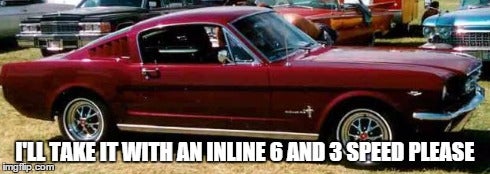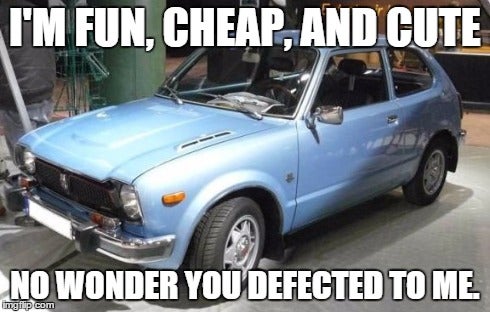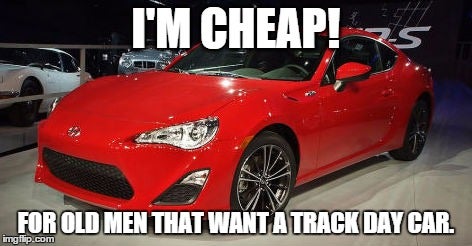 "RustyShitboxIsTheNewFast" (RustyShitboxIsTheNewFast)
"RustyShitboxIsTheNewFast" (RustyShitboxIsTheNewFast)
01/08/2015 at 17:29 ē Filed to: millenials, cheap new car, scion frs, mustang, civic
 3
3
 1
1
 "RustyShitboxIsTheNewFast" (RustyShitboxIsTheNewFast)
"RustyShitboxIsTheNewFast" (RustyShitboxIsTheNewFast)
01/08/2015 at 17:29 ē Filed to: millenials, cheap new car, scion frs, mustang, civic |  3 3
|  1 1 |
Itís an enigma wrapped in a puzzle wrapped in a mystery wrapped in a turkey wrapped in a waterproof coating. Why donít Millennialís buy new cars?
Nowadays there is a lot of talk about how the younger generation simply doesnít care about driving. The older generations simply canít fathom the idea of being youthful and being unable to associate that with the feelings they had when they were youthful and the fun that was to be had fucking shit up driving and exploring the world. The cause of this deviation of thoughts is often pondered upon before being dismissed as something you cannot understand, itís simply a sign of the times. And Iím going to tell you why thatís bullshit.
I would first like to say that young adults didnít always purchase New Automobilesģ, nor have they done so in quantity since the early Nineties.
Once Upon a Time in America, before World War 2, not too many young people drove. The more rural youths obviously drove to support their farms, and young parents obviously perceived a need for an automobile, but only the truly affluent kids drove for commute or pleasure. Cars were simply too expensive to purchase and maintain for the average family to have the kids driving. Then in the 1950ís, Americaís economy was enjoyed a massive post-war boom; in this boom the average household saw its income double in a decade. By 1965 the household income was around $7,000, up from $4700 in 1955.
Enter exhibit A:

The 1960ís Mustang.
The Mustang is a true testament to the power of the youth market. The first 1964.5 Mustangs cost under $2500, came with a 3-speed manual as standard, 2 seats ,were convertible or hardtop only, and weighed less than 2,500 lbs. There was no place for a Mustang in a world of necessity and family life, only in one of privileged middle class youths and disposable income. So in 1964 through 1965, over 1 million Mustangs were sold, finding their market in the burgeoning wallets of the middle America.
Then came the Camaros, the Chargers, the Firebirds, then the SSís, the Gt350ís, the Trans Ams. As time went on the engines got bigger, the cars garnered more acclaim, and were getting more expensive. This, and fuel was getting more expensive as the world was heading towards the gas shortage, led to the demise of the pony car being a youth oriented item in the late 70ís and 80ís.
Enter exhibit B

The first gen Honda Civic.
The first gen Civic being sold in the US was a response to the 1973 oil crisis, as well as the 1975 EPA emission standards being introduced. In Japan, Civicís and the like were used primarily by adults whose incomes were limited by the post war economic fallout, as well as by expensive fuel. However in America these cars were generally viewed as inferior to their much larger and thirstier American cousins, however they were also seen as suitable for kids since they were slower and cheaper to run. They were fun, comparatively quick, and light; it didnít hurt that they were engineered to a previously unseen standard at their rock bottom price. A 1974 Civic cost all of $2600 when the household income was around $12,000 per year. It was a mere penance to financially experiment with. Cars like this started to become more popular, Corollaís, cheaper VWís, FIATís, and even some domestic examples like the Chevelle and Omni, began to populate the streets.
Now we enter a time where motivations start to get a bit messy and unclear: the 1980ís. In 1986 oil hit rock bottom; the age of getting your kid a economy car to avoid the cost of gas was over. American cars were beginning to make more power while dealing with their restrictive emission standards; and imports were getting more expensive as their reputation for reliability and quality improved, as well as their home countries economyís improving. The household income was around $24,000, and cars had all gotten very competitive with one another. In this time everything was quite popular, Mercedes and BMW were making big gains in the market as the baby boomers taste grew to luxury, the Japanese continued to make good quality, cheap cars as well as starting to venture into experimental rocket-ship territory with the Rx-7ís and Starions, and the Americans entered the unfortunate period known as the ďmalaise eraĒ. They sold well enough,but were complete shitbuckets had fairly terrible economy, poor build quality, and are now generally known as a black eye on the American auto industry. They were bought mainly by patriots who wanted Something American Dammit!ģ, and were then punished for it.
Something new interesting happened in this era as well. For the first time there was the supply and the quality to support a true used car market. The less affluent of kids in this era looked to their favorite cars of yesteryear for their current transportation. It was finally that you didnít have to have disposable income and could rely on being somewhat savvy to get a reliable automobile. This would be the precursor to the downfall of youths buying new automobiles.
Because we enter the 90ís now with great trepidation.
In the 90ís the American public began to turn away from the American auto industry. The 80ís had simply been too emotional of a time with poor quality and engineering stagnation earmarking what should have been a golden era. In doing so and going to imports, they artificially raised the value of the automobile as a whole. The higher quality of imports also meant that the cars stuck around FOREVER, indeed late 80ís-90ís imports have reached a near mythic status in terms of longevity, and people were willing to pay more for their perceived reliability. This led to higher new car prices, along with a tremendously rising yen and mark/euro, was pushing up the price of the average car. Through the nineties we saw the Japanese cars price almost double, where German were priced above the means of the average person, and American cars were of doubtable quality and most of the creative effort went to the newly burgeoning SUV market. Kids of this era drove cheap economy cars, used or new. There were very few performance options accessible to kids of this generation, and the popularity of SUVs and luxury cars was choking out any chance of cheap cars gaining ground. In 1990 a Civic sedan cost about $10,500, when household income was about $30,000, and by 2000 it cost about $23,000, when household income was about $40,000. See what happened there? An affordable car went from one third of the household income to over one half of the household income, pricing themselves out of the range of most peopleís disposable income, hence out of the hands of middle class youths. Even the used market was getting more expensive as people paid more for yesterdays perceived reliability.
And we enter the 00ís to now.
Its been a hell of a rollercoaster up to this point, and it ainít stopping yet. The early 00ís saw the shut-down of everything fun and advanced as the yen spiraled out of control. Sales for sports cars and fun cars plummeted as the yen went out of control and the prices rose. Domestics hit rock bottom at this point, mostly with public perception, a lot with ignoring the quality in all but the most expensive vehicles. Germans stayed expensive and niche. The aging population of baby boomers still on the road demand luxury, and the middle class buy SUVs so they can fit their fat asses donít feel unsafe on roads filled with other similar, taller vehicles. Cheaper Carģ quality has waned dramatically as R&D focuses on the big money of luxury and SUV sales, but the prices have remained the same. As anyone who has driven a current Civic or Jetta as well as one from 14 years ago knows, the Affordable Carģ is dead; relegated to those with fond memories of yesteryear where it was a logical choice, where you could fit 4 adults into a midsize sedan and still have room for all their luggage; a time where a car and a truck sized car CUV werenít $2,000 apart. The Cheap Fun Carģ is Really Dead©, not seen around these parts since the late 80ís, the modern day equivalent costing so much theyíre viewed as toys for the rich or accessible-when-used.
Take exhibit C

The Scion FRS.
Seen as cheap, it will cost you near-as-makes-no-difference $28,000 for it today. The average household income is around $50,000, making the car damn near three fifths of the average income. Over half! Who says half their income is disposable? Nobody! So how is this cheap?
The simple truth of the matter is younger people seem to buy new cars when the price of the car doesnít exceed a third of average household income. This is just the same simple logic that has proven the car choice the average American makes is dictated by the price of gas. Itís a fact that is observable through the past 50 years; although I believe itís a matter of coincidence that the historically trend-setting cars are freaking kickass light and comparatively quick to their contemporaries, Iím sure it doesnít hurt to make a car a bit fun in order to sell it to younger people.
This article is full of assumptions and theories right from my head. They were put there by talking to The Old Guys Around©, many of whom enjoyed a new vehicle when they were young.
 HFV has no HFV. But somehow has 2 motorcycles
> RustyShitboxIsTheNewFast
HFV has no HFV. But somehow has 2 motorcycles
> RustyShitboxIsTheNewFast
05/25/2015 at 15:30 |
|
The reason I donít want a newer car is the technology. No not the stuff that makes cars ďlighterĒ and more powerful. No the stuff that locks your doors when you didnít want them locked, and tells you when and if youíre allowed to spin your tires a bit, or go over a certain RPM(the worst kind of traction control). The kind that beeps at you when your wiper fluid is low, or you donít have your seatbelt on. Than kind that has replaced those nice buttons on your radio with an Ipad so can use the GPS navigation, even tho you have a Tomtom in your glove box because you only need a GPS once every three months. Oh and tiny windows.
That is why I donít WANT a new car. Why would I pay a minimum of 300 dollars a month(200/payment 100/insurance) just to have a car that is more annoying, and more controlling. I want my FREEDOM dammit!